From the Front Lines: A Respiratory Therapist’s Plea for the Next COVID-19 Package
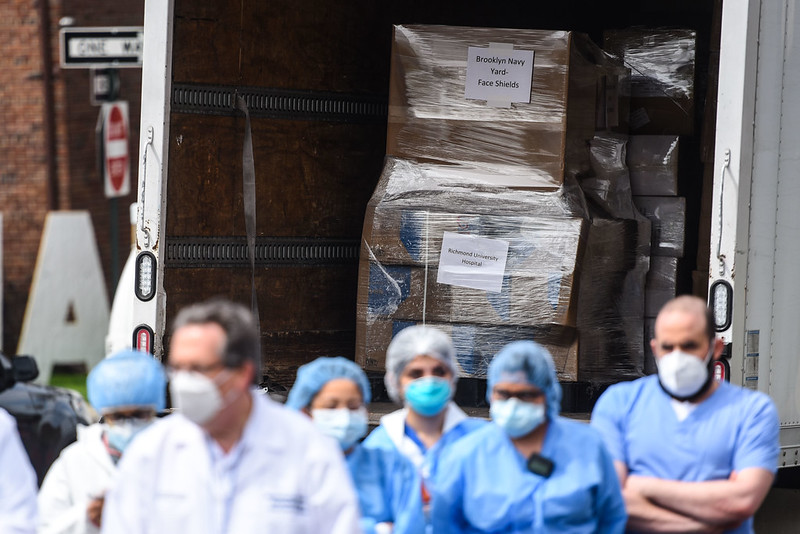
A frontline health-care worker on what's needed next from DC (photo: Michael Appleton/Mayor's Office)
It has been a challenging, frightening time for everyone, but especially for those of us working in health care. Amid all the suffering and anxiety brought about by COVID-19, health-care workers on the frontlines have continued to show up and display strength, faith, and courage in taking care of the most vulnerable.
During these difficult times, I have never seen such dedication displayed by my co-workers in health-care facilities across New York City and throughout the state. At times overwhelmed, emotional, and exhausted as the surge of the virus engulfed us, I’ve never regretted the career path I have chosen.
In 1997, I migrated from Trinidad to New York City and pursued a career in health care as a Respiratory Therapist. During my 18 years as a therapist, I have intubated and managed countless patients on a ventilator at my hospital in Brooklyn. But all of my education and experience has been tested by the challenge of this pandemic.
On a daily basis my co-workers and I experience a massive influx of critically ill patients, each exhibiting new and unexplained symptoms. Brooklyn has had more than 50,000 cases of COVID-19 alone. Additionally, we are all managing the daunting task of caring for our own families and co-workers who are threatened by COVID-19.
The people at my hospital and medical professionals around the state – many of whom, like me, are proud members of 1199SEIU – are committed to delivering the same high standard of quality health care, regardless of this outbreak. But to do that, we need every piece of our health-care delivery system doing its part: health-care workers, health-care facilities, health insurers, our community, and state and federal government.
The heartfelt thanks and gratitude we have received from our communities – including the nightly rounds of applause – have been overwhelming and are greatly appreciated. But these words cannot save lives. To provide the needed care at this critical and challenging moment, my frontline colleagues and I need help. In particular, we need the federal government to provide the financial assistance that my co-workers, our patients, and our state need to deliver quality health care.
As they continue to discuss the next stimulus package, Congress and President Trump need to do the following:
Personal Protective Equipment (PPE): Whether they’re working in a hospital, clinic, nursing home or delivering home care, all frontline workers must have enough personal protective equipment (PPE) to keep themselves – and their patients – safe. It’s frustrating for me and my colleagues that Congress could ever think this is up for debate. We can’t deliver great care if we can’t protect ourselves from the diseases we’re fighting each day.
Crisis Pay: Frontline healthcare workers who are risking their lives every day they go to work should receive some sort of premium pay that recognizes their courage and the sacrifices they make day in and day out.
And as offices and schools alike are closed, many parents are juggling working from home while caring for their children. This is no doubt a challenging task. But for parents like me and many of those I work with, working from home is not an option, and the unexpected costs of finding daycare for our children have added a financial burden to the physical and emotional burdens we’re undergoing.
Medicaid Funding: Medicaid covers a third of New Yorkers, including millions of children and seniors. As the pandemic continues and unemployment skyrockets, more and more New Yorkers need that coverage. Our Medicaid program is already stretched to the limit and is about to break unless the federal government does its part and provides more funding for this critical program. If our hospitals don’t survive, our patients don’t. Medicaid funding is essential for us to continue doing the work we’re doing to battle this crisis.
In recent days, we have begun to see the light at the end of this tunnel. But our work is far from done.
The next COVID-19 relief package is being negotiated on Capitol Hill right now and must address the lack of resources across New York. If we get the support we need and deserve from Congress and the Trump administration, together we will win this health-care battle. We, as frontline health-care workers, are committed to do our job. Congress and the President have to do theirs.
***
Allison Trubett has worked as a respiratory therapist in Brooklyn for 18 years. She is a member of 1199SEIU United Healthcare Workers East.
***
Have an op-ed idea or submission for Gotham Gazette? Email This email address is being protected from spambots. You need JavaScript enabled to view it.
Carbon Free Is How We Build Back From COVID-19
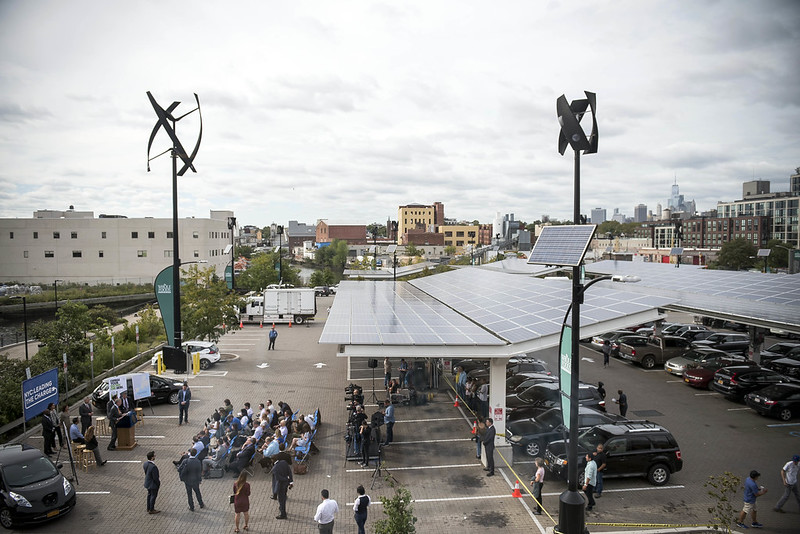
Is the post-coronavirus future renewable? (photo: Ed Reed/Mayor's Office)
There have been many hard-learned lessons from COVID-19, but by far the most tragic – paid for with the lives of tens of thousands of people – is that when it comes to dealing with a public health crisis, preparation and proactive planning is the only approach that can keep our worst nightmares from becoming a reality. While New York is still far from reaching the light at the end of the tunnel, many inside and outside of government have rightly begun to envision what a restart to our economy should look like.
It is in this conversation that we have a unique opportunity to get the restart right by appropriately investing in a cleaner, greener, and more energy-resilient economy that will have the dual benefit of driving much-needed job and economic growth statewide while also helping fortify our defense against the next impending crisis for which there can be no vaccine – that of climate change and its impacts. By ensuring that governments like New York State make our long-term climate change goals a priority as part of the economy-wide restart, we can meet our immediate economic and public health concerns, as well as better position our renewable and clean energy industry to reach our broader climate change goals.
While the public health concerns and dangers of coronavirus are very serious and science should be the determining guide for any economic recovery plans, we shouldn’t lose sight of the climate crisis and how these goals are inextricably linked. New York residents are clearly being harmed by a changing climate caused by carbon emissions, with unequal impacts on the state’s most vulnerable and disadvantaged communities. By starting anew with a clean energy economy, we can expect to greatly reduce the risk of the increasingly serious effects of climate change.
The evidence of New York’s changing climate are readily apparent across every region of the state: a 74% increase in extreme precipitation since the 1950s; an increase in extreme storms like superstorm Sandy, which cost $40 billion in reconstruction and tourism losses; extreme drought in the Finger Lakes; flooding along Lake Ontario’s shoreline; and overwintering pests destroying our forests and crops. Sea level rise is also impairing coastal communities and infrastructure such as airports and sewage treatment plants. Flooding disrupts communities, agriculture, and water quality. New York State’s temperature has increased 2.6 degrees Fahrenheit since 1897. Action is clearly warranted.
Unfortunately, the federal government has abdicated its responsibility to protect the environment; a recent New York Times analysis found that of more than 90 environmental rules and regulations rolled back under the Trump Administration during the last three years, 16 concerned air pollution and emissions.
Without sufficient action at the national level to enact any kind of impact solution to climate change, like a national carbon fee and dividend, it’s up to each state to implement clean energy policies. Governor Cuomo has thoughtfully proposed a gradual approach to reopening the economy, with lower risk activities beginning before others and the private sector doing its part by adjusting to minimize the risk of spreading the coronavirus. That same logic – with New York seeking to implement its own plan irrespective of federal inaction – can and should be applied to investing in carbon-free policies that can help restart our “clean” economy in a safe manner while also advancing climate crisis goals.
New York has always been a national leader in fighting the climate crisis. Last summer, the state enacted the Climate Leadership and Community Protection Act, a historic climate law that calls for 70 percent of the state’s electricity to come from renewable energy by 2030 and 100 percent of the state’s electricity supply to be emissions-free by 2040.
In an effort to reach those goals, the New York Independent System Operator (NYISO) has proposed a carbon-pricing plan. Nearly all leading economists agree that carbon pricing -- which puts a price on carbon emissions to disincentivize such pollution and fund clean energy projects -- is the most efficient single step we can take to significantly reduce greenhouse gas emissions. Furthermore, it costs the government virtually nothing, hits nearly every sector of the economy, and protects consumers from rising energy costs.
Citizens’ Climate Lobby New York (CCLNY), a nonprofit, nonpartisan, grassroots advocacy organization and member of the Carbon Free New York coalition, fully endorses the NYISO carbon pricing plan. If enacted, the plan will reduce carbon emissions in the electricity sector by 22 percent and generate up to $691 million in annual economic benefits by 2025.
According to a report by the Alliance for Clean Energy, the NYISO plan will not only accelerate the pace at which the state moves towards its goals for 2030 and 2040 laid out in the Climate Leadership and Community Protection Act, but it will also demonstrate to the world New York’s ability to integrate aggressive environmental goals with a competitive market structure. And it will amplify the renewable energy industry, reducing pollution in a densely populated area, while positively impacting public health outcomes – goals that have become even more important to our recovery from the COVID-19 crisis.
For a safer and healthier New York, we must be carbon free.
***
Lynn Meyer is New York State Co-coordinator for Citizens' Climate Lobby (CCLNY), an international nonpartisan volunteer organization that advocates for federal carbon fee and dividend legislation and a member of the CarbonFreeNY coalition.
***
Have an op-ed idea or submission for Gotham Gazette? Email This email address is being protected from spambots. You need JavaScript enabled to view it.
Surveillance and the City: Public Trust Needed for a Public Tracing System
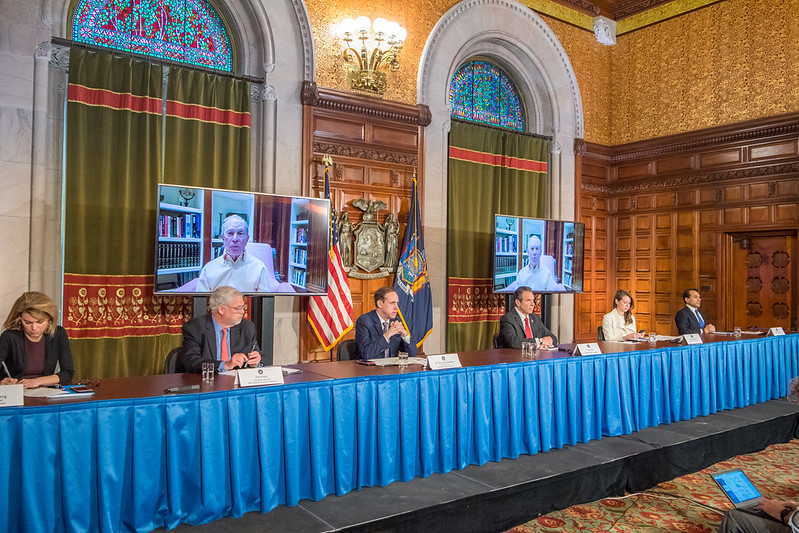
Bloomberg and Cuomo team up on contact tracing (photo: Darren McGee/Governor's Office)
The scene sounds familiar: Michael Bloomberg overseeing thousands of officials tracking where New Yorkers go and who they spend time with, all in the name of keeping us safe. In 2010, it was then-Mayor Bloomberg overseeing tens-of-thousands of NYPD officers as they stopped and frisked New Yorkers of color and spied on Muslim student groups and mosques. In 2020, it’s Bloomberg the philanthropist, helping to run the unprecedented effort to contact-trace the spread of COVID-19.
There’s a lot we don’t know about the state’s contact-tracing partnership with Bloomberg: who will have access to the data, how will data be kept, when (if ever) can data be shared with police. But there is a lot we do know about Bloomberg, facts that should give us pause about entrusting the most important public health effort in generations to the man who thought American Samoa’s presidential delegates were worth nearly $200 million.
Throughout his time as Mayor and short-lived presidential run, Bloomberg was a self-proclaimed stats guy, the man famous for saying: “In God we trust, all else bring data.” But for Bloomberg, data has a dangerous way of showing him what he already believes. Bloomberg views statistics with a Wall Street hubris, the mindset of the financial titans who assure us that they know exactly how to manage risk up until the moment everything crashes and they ask for the next bailout.
The truth is that data about human beings is almost inevitably biased, warped by countless subjective decisions that go into creating the data set. In finance, it was the logic of redlining that decided black homeowners were too risky to lend to, thereby depriving them of loans, and creating the self-fulfilling prophecy where many capital-starved black neighborhoods then saw higher rates of foreclosure after they were forced to turn to predatory lenders. It was the logic of stop-and-frisk, the racist policing practice that Bloomberg defended until the precipice of his presidential campaign, claiming “we put all the cops in minority neighborhoods. Yes, that’s true. Why do we do it? Because that’s where all the crime is.”
The problem is that communities of color weren’t the only place that “crime was,” it was just the only place where many laws were enforced. Looking back at my own lower Manhattan childhood, the reality is stark. Whether it was open container violations, drug possession, or other low-level offenses, we had these in abundance in wealthy white neighborhoods. The only difference is that no one was stopped for them, and thus the crime data showed they weren’t happening.
History is why so many New Yorkers want safeguards and answers before the Bloomberg partnership goes forward. At a time when the cash-strapped state is digging beneath the proverbial couch cushions for every spare penny, having Bloomberg finance the tracking program will come as a financial relief. But for contact tracing to be effective, Albany will need something more elusive than even Bloomberg’s billions: public trust.
Without public trust, without our willingness to hand over the most intimate details of our lives to a complete stranger, contact tracing will hit a dead end. Our ability to track disease is only as strong as the public’s ability to help. But rather than bending over backwards to reassure New York’s most vulnerable and potentially reluctant residents, the state’s leaders are dismissing the concerns out of hand.
When Public Advocate Jumaane Williams sent a letter to Governor Cuomo, asking for reassurances about Bloomberg’s role in the tracking program, the response was less than receptive. Rather than giving the city’s top civil rights watchdog the details requested, Cuomo’s spokesperson dodged most of his requests before saying “There’s enough real problems fighting this pandemic, and we have no time for politicians who create fake ones in a craven attempt to get in the paper.”
But that’s precisely the problem: privacy is already a part of the fight against the pandemic. If the Governor can’t give a clear and direct response to questions like, “who has access to the data,” then how can New Yorkers be expected to provide that data in the first place?
Throughout the COVID crisis, the Governor has doubled down on his impulse to act unilaterally. Some of those decisions have helped safeguard the state, but others have likely cost us lives and wasted millions (if not billions) in public funds. But this is a part of the COVID battle that Cuomo can’t fight on his own. A trusted, inclusive, culturally-competent contact-tracing system will require unprecedented public support.
If we go forward with Bloomberg at the center of the effort, then it will put even more pressure on state leaders to win the public’s trust. If we disclose all the details possible, create the strongest privacy safeguards in the country, and have a sustained public engagement campaign, then this might all just work. But if we don’t act now to prove to the public why this scheme is safe, then not even Bloomberg’s checkbook will be enough to erase his checkered privacy past.
***
Albert Fox Cahn is the executive director of The Surveillance Technology Oversight Project at the Urban Justice Center, a New York-based civil rights and privacy organization. He writes the monthly "Surveillance and the City" column for Gotham Gazette. On Twitter @FoxCahn.
***
Have an op-ed idea or submission for Gotham Gazette? Email This email address is being protected from spambots. You need JavaScript enabled to view it.
Governor Cuomo Owes Subway Riders and Homeless New Yorkers A Housing Plan
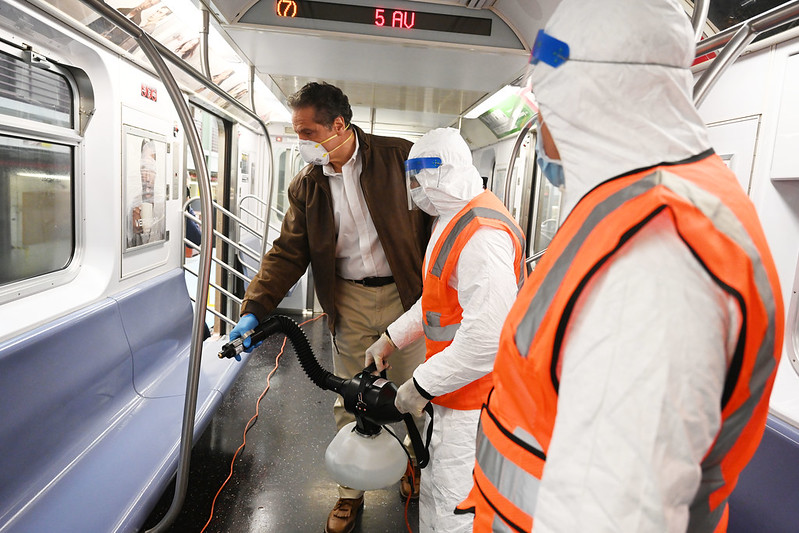
Governor Cuomo disinfects a subway car (photo: Kevin P. Coughlin/Governor's Office)
The subway is New York’s circulatory system. If it doesn’t recover, New York won’t. But reopening the subway and the city means more than running more trains: It also means helping homeless New Yorkers who today have nowhere else safe to go.
That is because, as Governor Cuomo demonstrated, the city’s transit crisis is too entwined with its housing crisis for the MTA alone to bring the subway back. In response to the rising number of New Yorkers with no choice but to seek shelter underground, the governor took the most dramatic step he’s taken since putting the state on pause: closing the subway system between 1 and 5 a.m. each night.
The end of 24-hour-a-day subway service made international headlines. In a cruel twist of irony, New York may no longer be the city that never sleeps and at the same time has one less place for unhoused people here to bed down. But closing the subway will not prevent people from sleeping in the transit system, so long as no other safe options are available. To date, the governor and Mayor de Blasio have refused to offer hotel rooms for homeless individuals on the streets or subways who need safe spaces to socially distance and take care of their basic human needs. Although the Mayor has touted that 1,000 people are being moved from congregate shelters to hotel rooms each week, thousands of homeless New Yorkers still face a heightened risk of contracting COVID-19 in congregate shelters -- and those on the streets and subways are not offered these hotel placements directly.
For several decades, as rents have risen, wages have not kept pace. In the past 15 years, New York City has lost more than a million low-rent units, and housing construction for extremely low-income and homeless households has not kept pace with that loss. That inequitable mismatch has increased the number of people who can’t afford a place to live, whether or not they work. Moreover, the shocking economic and health effects of the coronavirus pandemic have forced newly homeless people onto our streets and into the subways.
While New York City maintains a legal right to shelter, the congregate nature of many shelters is simply not safe, as evidenced by the spread of COVID-19 throughout approximately 171 shelters so far. Homeless New Yorkers on the subways know this and are consciously and reasonably refusing to enter shelters and risk their health.
At the same time, New York City needs 24-hour subway service. A significant number of riders -- many of them essential workers -- depend on the subway for travel between 1 and 5 a.m. and have no other option. Essential workers in health care, food service, building services, and more ride transit overnight while the rest of us sleep. Overnight subway service is essential to restore our 24-hour economy as soon as is safely possible. A full recovery is unimaginable without it.
Meanwhile, daytime service, which moved several million people daily for more than a century until March, will falter if crowding is unmanageable as New York reopens. As more New Yorkers return to work, the ability to maintain social distance on the commute is key. Governor Cuomo must ensure subway riders have more space than before. But to reliably limit crowding and keep both homeless and housed New Yorkers safe, he will also need to safely house people who have had to resort to sheltering inside subway cars.
The answer to homelessness in our transit system is not to drive people off the subway and further into the shadows, further from the help they so desperately need. The answer is to offer them safe temporary shelter and permanent housing. Right now, the city and state are deploying NYPD, MTA Police, and outreach workers to clear trains at night and offer “services.” These services are in the vast majority of cases a transport to an unsafe congregate shelter. Many individuals on the trains are aware of the risks of COVID-19 in shelters and take their chances on the streets instead.
City Council Speaker Corey Johnson and Council Member Stephen Levin recently proposed opening the city’s more than 100,000 empty hotel rooms to homeless people. This sensible option can provide the safe, private accommodations everyone needs to ride out the pandemic. With no indication when tourism will return, allowing homeless individuals on the streets and in the transit system to immediately access hotels is a creative, humane, and efficient way to match surplus with need. It is the right thing to do.
Similarly, state legislators led by Assemblymember Andrew Hevesi and Senator Liz Krueger have long advocated for state-funded housing vouchers to move people off streets, out of shelters and other public spaces, and into homes of their own. The Home Stability Support program and more permanent supportive housing would put state resources behind ending one of the harshest manifestations of life in the most unequal state in the nation.
In the coming weeks, these worthy proposals should form the basis of a housing plan fit for the subway that will keep riders safe. To reopen New York to everyone, around the clock, Governor Cuomo must seize the moment to meet New Yorkers’ housing needs.
***
Danny Pearlstein is Policy Director at the Riders Alliance. Giselle Routhier is Policy Director at Coalition for the Homeless. On Twitter @dannypearlstein & @RidersAlliance & @giselle_ashley & @nyhomeless.
***
Have an op-ed idea or submission for Gotham Gazette? Email This email address is being protected from spambots. You need JavaScript enabled to view it.
New York City Must Keep and Expand Organics Collection, It’s an Essential Service
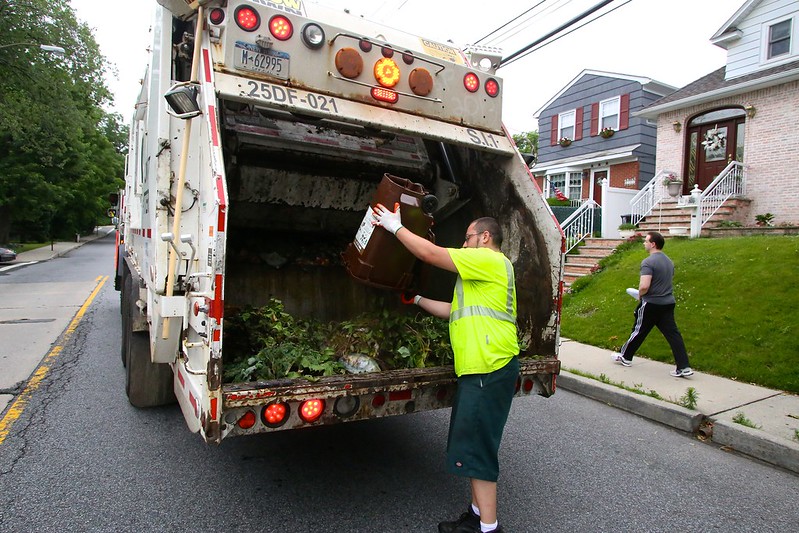
Organics collection (photo: NYC Department of Sanitation)
Among the businesses listed as essential in Governor Cuomo’s PAUSE order are "trash and recycling collection, processing, and disposal" industries. Yet on April 7, Mayor de Blasio followed a different interpretation by announcing that the Department of Sanitation’s organics recycling program would be eliminated on May 4. To do away with this critical environmental program just to save a miniscule percentage of the city’s budget doesn’t make sense, and here’s why:
While it is no secret that the city’s curbside organics collection program doesn’t pay for itself, that’s only half the story. It is true that the program currently generates a small amount of revenue, about $50,000. However, if properly executed, the program has the potential to generate millions of dollars in revenue for the city.
In a February 2019 study, "How Much Potential Revenue are New Yorkers Wasting by Trashing Organics?," the city’s Independent Budget Office calculated that if all of the 1 million tons of food and yard waste generated by New Yorkers annually were recycled into compost, it could produce $12.5 million in revenue. If the same annual tonnage were recycled into biogas and used to generate electricity, the potential revenue could be as much as $22.5 million.
We can only realize the untapped financial potential of the organics program if enough New Yorkers separate their leftover pizza crusts and banana peels from their trash and into the city's brown bins. Cutting the program nixes the opportunity for that to happen and washes away years of gains in a single stroke. What the city should do is pursue an "expand to save" model, accomplishing multiple goals at once.
Realizing the increased revenue from organics recycling is dependent upon expansion. An investment in our organics program now will save money in the long run, all while helping our planet. It’s a win-win.
Furthermore, history suggests that eliminating the program now means it will be that much harder to bounce back if it is ever restored. When the Bloomberg administration suspended plastics and glass recycling in 2002, in the midst of another recession, New Yorkers were recycling at a rate of about 20%. Recycling has never returned to the same level after it was brought back; the latest available data, from fiscal year 2019, shows an 18.1% recycling diversion rate citywide, a decade and a half after. Changing habits is hard.
Loss of New York City’s composting program would also have implications for the cleanliness of our city. This could mean an uptick in rats and other vermin. Currently, buildings that participate in the curbside organics collection program store their food scraps in rat-proof brown bins provided by the Department of Sanitation. Once brown bin collection stops, the same amount of organics will end up in garbage bags stacked on sidewalks, a ready feast for rats. To make matters worse, the mayor has also proposed eliminating fourth-day garbage collection in "Rat Zones."
Ending the curbside collection of organics is short sighted and ill-advised. It’s penny-wise and pound-foolish in a time when we desperately need to be thinking about how to build a resilient city. The health and longevity of our neighborhoods, city, and planet should be paramount, especially in times when tough decisions need to be made about our city’s budget and how the fiscal decisions we make today will impact our future.
The CORE Act, being introduced on Wednesday by City Council Members Keith Powers and Antonio Reynoso (a co-author here), would provide New Yorkers with places to drop off organics, electronics, textile, and other materials for recycling, as an interim measure until we restore and expand curbside collection of these streams to all New Yorkers. We know from recent history that the relatively little we save with a cut like this doesn’t justify the decades it will take to rebuild the good that it does for New Yorkers.
***
Gale Brewer is the 27th Borough President of Manhattan. City Council Member Antonio Reynoso represents parts of Brooklyn and Queens and chairs the Council’s Committee on Sanitation and Solid Waste Management. On Twitter @galeabrewer & @CMReynoso34.
***
Have an op-ed idea or submission for Gotham Gazette? Email This email address is being protected from spambots. You need JavaScript enabled to view it.
Coronavirus Shows Just How Much the Census Counts

Federal aid to New York City is even more urgent than ever (photo: Michael Appleton/Mayor's Office)
While many of our daily activities remain on hold, the 2020 Census must still be taken and completed this year. Not only is it required by the U.S. Constitution, but there is a tremendous amount at stake for New York, including billions of dollars in federal aid, a fair allocation of seats in Congress, and accurate representation in state and local government. From road repairs to education and social services, over 300 federal programs are driven by census data.
Through my work at New York Law School and the statewide New York Counts 2020 census coalition, I have been collaborating with New Yorkers on best practices and strategies to ensure an accurate census count. What we cannot overlook—especially now—is that the census is critical to protecting us from future pandemics. An accurate census count is crucial to securing enough hospitals, medical facilities, doctors, nurses and medical supplies so that we’ll never again see the kinds of shortages we are seeing today. That’s because health care providers, insurance companies, and government officials all make important decisions on where to provide resources and assistance based on census data.
Unfortunately, while this year’s count is especially important, it’s also far more challenging than any in our country’s history. And right now, New York is lagging behind other states. As of May 8, only 52.4 percent of New York State’s households have responded in the first few weeks of the census counting process, placing New York 42nd among the 50 states.
The census has never been a perfect count. In fact, well before COVID-19 struck, the Urban Institute estimated that New York could be undercounted by 313,700 people this year. That’s almost half the population of one of our congressional districts.
But COVID-19 puts us in danger of a far more severe undercount that will impact our state for years to come. Some of lowest response rates are in communities hit hardest by COVID-19, the result of income and racial inequality. These are the same areas that have also been historically undercounted and neglected, and without an accurate count, they will not receive adequate government support.
Everyone has a role to play in the solution: our government leaders, community organizations, experts, and fellow New Yorkers. Since person-to-person outreach cannot take place, outreach groups must rely on text messages, phone banking, emails, Zoom sessions, and postering to reach communities that have been historically undercounted. I’m encouraged to see several areas asking grocery stores and other essential businesses to place 2020 Census flyers in bags as a reminder. These are the kinds of actions we need now.
While I applaud the U.S. Census Bureau for extending the counting period until October 31, with so much uncertainty due to COVID-19, this still may not be enough time. If census workers are not able to visit homes directly, then we will need to build new strategies to reach people through social distancing, media, and other creative methods never tried before.
With so much at stake depending on an accurate census, everyone who can respond must do so. Census information cannot be shared with any other government agency, and there is no citizenship question. It’s easy to fill out and can be done online, over the phone, or by mail.
Now more than ever, answer the census. Take 10 minutes to answer 10 questions, which will help New York for 10 years.
***
Jeffrey M. Wice is an Adjunct Professor and Senior Fellow at New York Law School and head of the school’s New York Census and Redistricting Institute. On Twitter @JeffWice.
***
Have an op-ed idea or submission for Gotham Gazette? Email This email address is being protected from spambots. You need JavaScript enabled to view it.
To Reopen Schools, The Mayor Needs Smaller Classes - Here’s $570 Million in Potential Department of Education Savings to Get Him Started
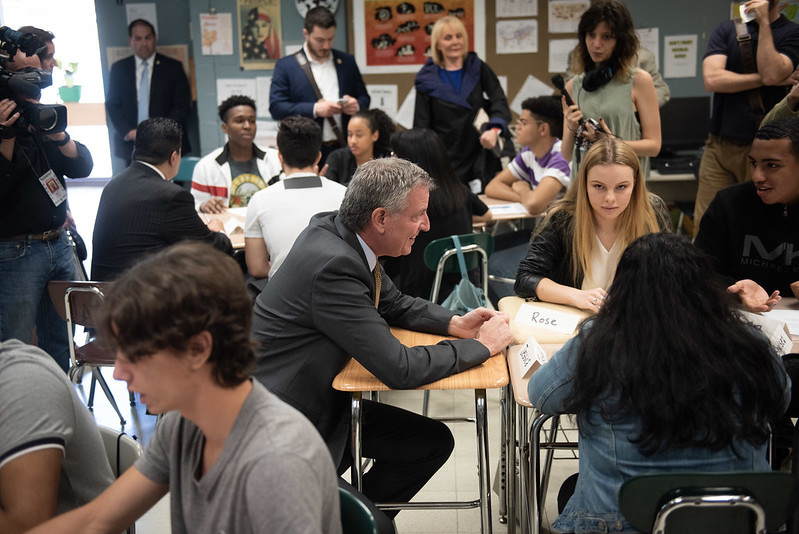
Mayor de Blasio needs a plan to reopen city schools (photo: Michael Appleton/Mayor's Office)
The New York City Department of Education has lost 74 employees to the novel coronavirus, including 30 teachers and 28 paraprofessionals who have died as of May 8. Evidence has also emerged that children can develop serious illnesses after being infected with the virus, and even those who are asymptomatic are often effective transmitters.
Now that both Mayor de Blasio and Governor Cuomo have wisely decided that our public schools will be closed through the end of June, it is time to start thinking about how they will be reopened in the fall to maximize the health and safety of students and staff, and strengthen the academic and emotional support that our students will need to make up for the myriad losses they have suffered this year.
As Mayor de Blasio has said, “Next school year will have to be the greatest academic school year New York City will ever have because everyone is going to be playing catch up.” And yet he has also proposed over $800 million in reductions to the Department of Education, including staffing freezes and at least $140 million taken directly out of school budgets, which would likely cause class sizes to grow even larger, the loss of school counselors and more.
How could next year be the best year ever, given such drastic reductions? In fact, our schools will need increased investments to provide the enhanced feedback and engagement that students will so desperately need after months of isolation and inadequate remote learning.
Many countries, including Denmark, Germany, and France, are gradually reopening their schools while implementing new protocols including frequent handwashing, temperature-taking, and reducing class sizes to obtain the recommended social distancing within classrooms and prevent the spread of the virus. Some are lowering class size by limiting the number of students into the school at any one time through split or staggered schedules. The American Federation of Teachers has recommended class size reduction be achieved in schools throughout our nation as well: “one of the most important measures districts can take is to reduce class sizes…Class sizes of 12-15 students will, in most circumstances, make it possible to maintain physical distancing protocols.”
Smaller classes have also been shown through research to boost learning and provide the social and emotional connections that many students will need from their teachers, given the loss in learning, isolation, and stress caused by the pandemic this year. Shouldn’t class size reduction happen here too, and if so, how?
Clearly, every available space would have to be used in our school buildings to accomplish the physical separation and smaller classes required. Split sessions would also be implemented in overcrowded schools, and more funding for additional staffing. At first glance, this would appear impossible, especially given the economic crisis the city is facing. Yet considerable savings could be obtained by cutting other, less critical areas of the education budget.
As a letter signed by 34 City Council members pointed out, the city should reduce spending on “consultants, administration, cancelled or unnecessary testing, and contract[s]” rather than cut school budgets.
Prominent among potential savings this year is a big chunk of the $1.1 billion spent annually on school busing, given that these buses haven’t operated since mid-March. Parents and advocates began a campaign against wasteful spending on unused busing, and City Comptroller Stringer sent a letter to the chancellor, pointing out that the city had no legal obligation to renew these contracts in the midst of a pandemic. Following this, the DOE postponed the vote originally scheduled for the Panel for Educational Policy on April 22 to approve $400 million for extending busing contracts through March and April. Cancelling these contracts through the end of the year could save as much as $700 million.
Considerable savings could also be achieved this year in energy, facilities, and supplies, given the fact that school buildings will be closed three-and-a-half months by the end of June, and will likely shut over the summer as well. About $570 million was allocated for energy and leases this year – with more than $175 million for energy and fuel costs alone. Surely, at least $25 million could be saved in this category.
While the Department of Education has proposed to freeze the hiring of teachers, counselors, and aides, they plan to increase spending on School Safety Agents who are hired by the police, spending a total of more than $432 million. School Safety Agents already number over 5,500, more than the number of counselors, social workers, and school psychologists combined. If the spending on these agents was merely frozen at last year’s levels, that would save at least $5.6 million right there.
There are also considerable cuts that could be made to the bureaucracy: 155 employees were added to the DOE’s central administration in 2019, and 185 more to borough offices. Large raises were awarded to administrators, leading to a 50 percent increase in the number of bureaucrats who earned more than $200,000 per year.
The mid-level bureaucracy, which includes borough offices, has more than doubled in expenditures to $351 million since de Blasio was elected. If spending on that level returned to what was spent in 2014, that alone could save another $147 million.
This fall, DOE ordered many schools to administer computerized MAP assessments, which officials testified in the future all students would be required to take several times a year. According to the comptroller’s Checkbook NYC, the cost of the contract with NWEA, the company that produces these assessments, is $5.25 million, with $1.66 million spent to date. Yet a randomized experimental study showed that the use of MAP exams was not correlated with any gains in student achievement, and many educators as well as researchers question their validity.
With more than $570 million in savings described above, we could prevent any cuts to school budgets and allocate at least $100 million to hire staff to lower class sizes, as many parents, education experts, and advocates urged at standing room only City Council hearings held in February before the pandemic hit.
Moreover, about one-third of elementary grade classes and 40 percent of middle school classes are inclusion classes, meaning that they include both general education students and students with disabilities and have two teachers per class. Strong consideration should be given to dividing these classes in half, while keeping their inclusive nature, which would allow for class sizes of 10 to 16 without any additional hiring.
New York City schools also have an average of 14 students per teacher, while average class sizes are nearly twice as large. Thousands of push-in specialists, as well as other personnel, such as literacy coaches who generally spend little actual time working directly with students, are already on staff. Many of these instructional personnel could be re-deployed and assigned to teach their own classes, at no added expense.
If split schedules are introduced, intensive tutoring should be provided to students when they are not attending school, either at their homes, or in community centers or other locales. This could be done by enlisting thousands of volunteers from well-established organizations such as Literacy Inc., as well as recent college graduates whose salaries could be subsidized through the AmeriCorps program.
Our public schools still have not fully recovered from the last economic recession in 2007-2008, when class sizes increased sharply. This fall, there were more than 325,000 students in classes of 30 or more. The number of children in grades 1 to 3 in classes that large has risen by more than 3,000% since 2007.
Over this period, student achievement in New York City has remained stagnant or declined, as measured by the NAEPs, the most reliable national assessments. We simply cannot afford to allow them to lose any more ground. Through creative thinking and targeted savings that could be used to pay for more teachers, counselors, and tutors, and redeploying other instructional personnel already on staff, smaller classes could be achieved next year, schools could provide the necessary social distancing, and students receive the instructional and emotional support that they will need more than ever before.
***
Leonie Haimson is the Executive Director of Class Size Matters. On Twitter @leoniehaimson.
***
Have an op-ed idea or submission for Gotham Gazette? Email This email address is being protected from spambots. You need JavaScript enabled to view it.
Opening Up New York’s COVID-19 Data Can Save Lives
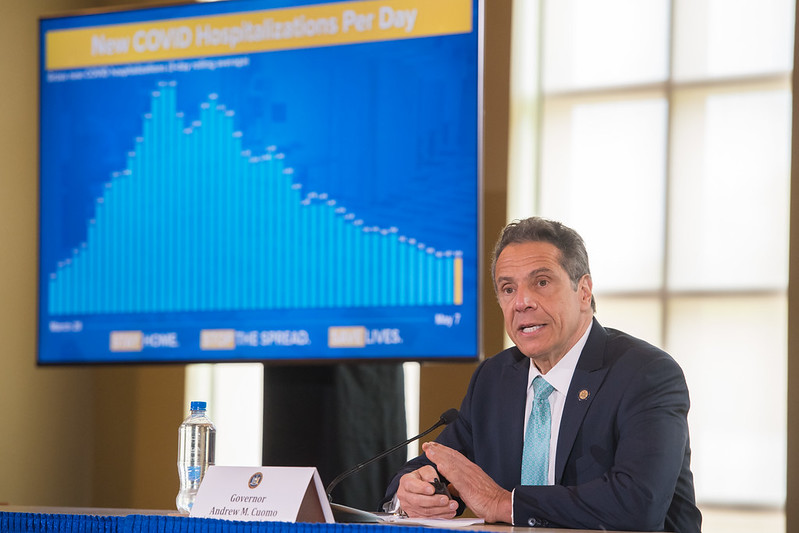
(photo: governor's office)
WHEREAS, Open Data Can Make New York Government More Transparent and Accountable in Order to Promote Public Trust and Save Lives During the COVID-19 pandemic...
Something close to this is the preamble to Governor Cuomo’s 2013 Executive Order 95, which created the state’s open data program almost simultaneously with New York City’s pioneering Open Data Law. What does open data have to do with a massive pandemic and economic shutdown? Well, just about everything.
The COVID-19 pandemic has highlighted the importance of public trust in government. Fortunately, New Yorkers have overwhelmingly heeded the governor’s and mayor’s mandates to socially distance and wear face coverings. This basic trust has slowed the virus in New York and saved lives. Unfortunately, there is a long way to go before New Yorkers have seen the last of COVID-19. The New York Times just reported the Centers for Disease Control is internally predicting a massive increase nationally in COVID-19 cases and fatalities in late May and June.
New York is not an island. As long as COVID-19 cases are skyrocketing nationally, we will be at high risk of reinfection. Given how much death, misery, and economic suffering we have already experienced, it will require great trust and patience with our state and city governments for the public to keep heeding inconvenient and onerous public health rules. We must have trust in governments’ ability to test, track, and report to us.
One important way New York can earn public trust is to open up the huge amounts of data related to COVID-19.
Last month, Reinvent Albany, BetaNYC, and six other watchdog groups sent a letter to the governor asking that all of the state’s data on COVID-19 be placed in the open data portal (a separate letter from seven groups went to the Mayor asking the same). New York State and City’s COVID-19 pages provide more data than most other governments, but they provide very little open data – data that is downloadable, sortable, and machine-readable. Despite all the charts on the New York state COVID-19 tracker, only a single dataset is provided in the state’s open data portal, whereas none of the city’s Department of Health and Mental Hygiene (DOHMH) data is centralized on the city’s open data portal.
Withholding open datasets creates an unnecessary burden for the public and sows doubt. If someone wants to analyze the data on New York state’s COVID-19 page, they must go through the tracker and enter all of the numbers into a spreadsheet manually. Some datasets – such as deaths by date – aren’t even provided in the tracker and can only be found in the governor’s daily powerpoint presentations. Likewise, too many of the city’s datasets are only available in PDF format, with some open data on GitHub, meaning that most city data also requires manual formatting. Both the state and the city could remove this time-consuming process by simply opening up all of the data on COVID-19. How can we trust the government's response if it isn't sharing data in an accessible way?
Both New York State and City need to make all of this information available in their Open Data portals, and the datasets must be as granular as possible, with discrepancies addressed and logged. The state should be sharing county-level data. The city should be sharing data down to the Neighborhood Tabulation Area (NTA) – the same level of data the DOHMH shares about 100 other measures via the New York City Neighborhood Health Atlas. There are legitimate concerns about the need to protect New Yorkers’ privacy during this crisis, but the DOHMH has a simple process for sanitizing the data to ensure civil liberties aren’t violated.
Releasing New York’s COVID-19 data will be crucial to prepare for second or third outbreaks, which experts say are likely to occur over the next year. To prevent more tragedy, New York will need to know where the virus travels, whom it is affecting, how it is getting there, and who is most at risk. This doesn’t mean that the city should limit its datasets to in-house experts – instead, the data should be opened up so that the informed public can share its own analysis and insight rather than being restricted to official narratives.
Open data is key for building public trust in government. Seeing how our governments are operating enables the public to better understand its operations. Trust is what gives government the latitude to do more good work. Times of crisis may seem to make open data less of a priority, but these times are in fact when open data is needed the most.
***
John Kaehny is executive director of Reinvent Albany. Noel Hidalgo is executive director of BetaNYC. On Twitter @JohnKaehny & @ReinventAlbany & @noneck & @BetaNYC.
***
Have an op-ed idea or submission for Gotham Gazette? Email This email address is being protected from spambots. You need JavaScript enabled to view it.
Coronavirus Crisis Again Shows New York Must Ensure Long-Term Support of Grassroots Emergency-Response Groups
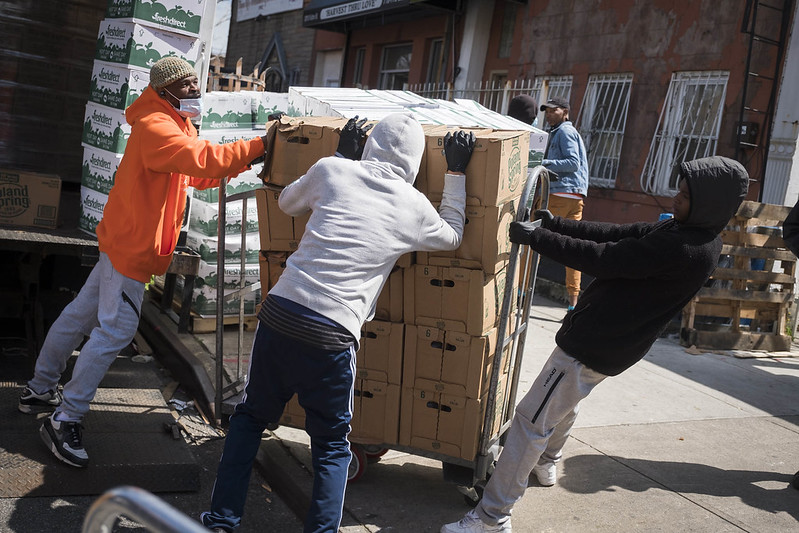
Community groups can organize other community groups (photo: Ed Reed/Mayor's Office)
Every day, New Yorkers are faced with the realities of the COVID-19 pandemic, an unprecedented public health and economic crisis ravaging our city. As the federal government continues to recklessly shirk responsibility, state and city governments strain to support hospitals and those impacted by the pandemic with their depleted budgets, leaving low-income and marginalized communities more vulnerable than ever.
In their wake, mutual aid and nonprofit organizations are expanding the critical work they do in their communities in an effort to make up the difference. In fact, when New York is faced with crisis, it is often our community-based organizations that respond most quickly to deliver aid and emergency services in neighborhoods across all five boroughs. These organizations are often unfortunately doing this crucial work without coordination, which as we’ve seen in our public and private hospital systems, can result in duplicitous efforts and competition for the same resources to serve the same people.
When faced with an emergency, where organizational leaders cannot attend each other’s planning meetings or digital town halls to coordinate efforts, we must ensure that mutual aid groups and nonprofits are working together to deliver the most good to the greatest number of New Yorkers.
New York City government has a responsibility to step in and assist these efforts. We are calling for legislation that would require the city to create a framework to support and aid in the creation of emergency community response groups, arming every neighborhood with an established means of coordination among community-based organizations when disaster strikes. In the spirit of continuity and improvement, we must learn from our response to this and previous disasters and prioritize funding for preparedness groups and Voluntary Organizations Active in Disaster, otherwise known as VOADs.
Such legislation could be modeled on creating more standing coalitions such as LES Ready! - a grassroots coalition of community organizations across the Lower East Side and Chinatown that was developed in response to Superstorm Sandy, to ensure there is an active and coordinated community-based emergency response.
Thanks to LES Ready!, the efforts of our existing community-based organizations, mutual aid groups, and nonprofits in our neighborhood have been streamlined and effective in ensuring that vulnerable community members are receiving the food, medical attention, and emergency resources they need. Every group in LES Ready! is part of a larger communications structure that knows what the others are doing and ensures an exchange of critical information. The coalition also has a direct line to the city’s Office of Emergency Management both during non-emergency periods and in the midst of crises.
These community networks are needed even more for the COVID-19 pandemic, which is proving even more devastating to our communities city-wide than Superstorm Sandy or the September 11, 2001 attacks. A survey conducted by the New York Federal Reserve found that the pandemic could wipe out about one-fifth of the city’s small businesses. While the federal government has allocated billions of dollars in funding to bolster the economy, distribution efforts have been chaotic at best. Overwhelming demand, shifting borrowing rules, regulations that favored big corporations over small minority-owned businesses, and a lack of infrastructure have all combined to create a bureaucratic nightmare for businesses on the brink.
By contrast, our local groups have responded quickly to the challenge. For example, AAFE, a long-time community lender, was able to establish an emergency loan fund repurposing existing loan capital and private bank fundraising by mid-March. The first loan was processed less than a week after the fund was announced.
AAFE and its fellow local community-based organizations, mutual aid groups, and nonprofits are able to be so nimble because of the coordination made possible through local grassroots networks and routine communication with agencies and officials. With a similar framework supported, funded, and implemented in every neighborhood across all five boroughs, the response efforts of all community-based organizations could be just as effective in delivering crucial support where it’s needed as quickly as possible.
And as part of this focus on community-led approaches to planning for and recovering from disaster, we must also establish a civilian advisory board with the capability to evaluate the city’s disaster response efforts. This board would oversee how the city is spending its resources and fostering communication with the groups on the front lines to help ensure, when the time comes, that direct public emergency services are getting to where they are most needed.
The COVID-19 pandemic has revealed so many gaping holes in local and national government systems and structures. In this period of crisis it feels impossible to look beyond the next week, or even the next day, but we must do so to ensure we are applying the lessons of today to the tests of the future.
New York will overcome this crisis. Let’s be sure we’re best prepared to overcome the next one, too.
***
City Council Member Carlina Rivera represents parts of Manhattan. Thomas Yu is the Co-Director of Asian Americans for Equality. On Twitter @CarlinaRivera & @AAFE1974.
***
Have an op-ed idea or submission for Gotham Gazette? Email This email address is being protected from spambots. You need JavaScript enabled to view it.
Solving the School Nurse Crisis Before Schools Reopen
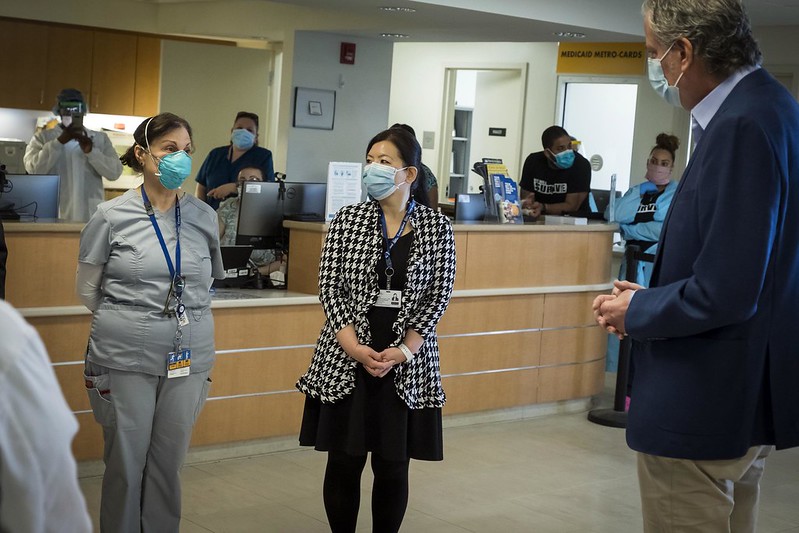
Mayor de Blasio talks with nurses (photo: Ed Reed/Mayoral Photography Office)
Long before COVID-19, New York City schools were dealing with a public health crisis: a lack of full-time nurses. Despite operating more than 2,000 schools, the city only employs around 1,400 nurses. It outsources others through private companies, wasting precious tax dollars, more than $100 million per year, on profiteering vendors rather than investing in the nursing staff that our schools need. And that they will need even more once schools open back up.
On Thursday evening, the Panel for Educational Policy approved two emergency contracts to hire additional private nurses for schools, a move that city leaders say is needed to ensure that enough nurses will be available to open schools. However, this approach will only perpetuate a major problem that has been developing for nearly a decade. New York City schools must employ at least one full-time nurse in each school building.
In March, Mayor de Blasio made a promise to have a nurse in each school, but he brought in 85 nurses to assist in filling more than 400 vacancies. It made no progress toward the level of health care that our schools need.
New York City leaders keep sweeping this problem under the rug. With a shortage in the nursing profession, two employment castes along with two union contracts, and an increasing need for medical care within the student population, the work has become one of those complicated issues that is often treated with equal parts passion and paralysis in the offices of elected officials.
Back in late 2018, me and my colleagues from the Community Education Council, District 3 (CEC3), held a public meeting where Dr. Roger Platt, from the Office of School Health, explained the employment structure to Upper West Side and Harlem parents. We couldn't believe how flawed the organization seemed to be, to have roughly 2,000 schools - public, charter, parochial, and private - serviced by only 500 nurses who are employed by the Education Department and 900 nurses employed by the Health Department. This pool of 1,400 “full-time” or permanent nurses had to be supplemented by hundreds of other nurses who were hired via private vendor contracts.
Union contract agreements complicated the matter further, because as it was later discovered, only the Department of Education (DOE) nurses are really full-time. With the support of the United Federation of Teachers (UFT), these coveted nursing positions enjoy salaried work with benefits and pension, working the school year like most teachers. The Department of Health (DOH) nurses are permanent employees but paid an hourly wage (not equal to that of DOE nurses) and overtime. Some, plus DOH nursing supervisors, are also expected to work throughout the year, and their benefits are not as robust as those of the DOE nurses. These nurses are represented by DC37.
Looking to private nursing companies to staff schools, so as not to deal with the full-time employment issue, seems to be the main driver for so many agency contracts, but there are serious problems with this rationale. For starters, taxpayers are paying for the profits made by the private vendors, who don’t typically pay their nurses all that well. Outsourcing essential government jobs wastes money and also falls short on the quality of work that is needed.
More importantly, unlucky schools without a full-time nurse often don't know who will be serving their students. Often these are the schools with higher rates of asthma, diabetes, and other conditions that demand medical attention for students. Some schools in Northern Manhattan and the South Bronx have asthma rates as high as 40%. Other health conditions are also on the rise, many of which require daily care such as injections, catheterizations, and medication administration.
Contract nurses sent in as subs also don’t even have access to the “Automated Student Health Record” (ASHR) system. When they see a sick student, they have to rely on accurate written records, if any. They complete a written document of the visit, which technically should be entered into ASHR but isn’t. ASHR also informs New York City’s “syndromic surveillance” capabilities, a database of citywide disease information that is more important than ever.
Before the pandemic, more than 50 New York City schools operated without a nurse on staff at any given day. This led principals to make more 911 calls, taxing our emergency response system. They also had to place calls to parents with children who require skilled nursing care, leading to higher student absence rates. Some parents simply pulled their children out of the DOE and resorted to homeschooling.
To nursing supervisors, this patchwork system has meant a persistent shifting around of schedules, absences, and other issues related to working with independent contractors. It held up the heavy data flow of information related to medication administration forms, because they too get entered into ASHR. But this particular task is a constant reminder of how flawed the school nurse structure is for student care.
New York City has not prioritized school nurses for years. COVID-19 has shown us all how essential our school nurses are and will even more so when school buildings open again. The Panel for Educational Policy vote on private vendor contracts highlights the city’s reluctance to deal with the problem fairly and equitably. But there is still time to make progress on this issue.
City leaders can bring the right people together to restructure the employment model and create a pipeline for the hiring process. We need a school system that truly serves our children, and that means that every school should have a full-time school nurse when we resume normal operations in the fall.
***
Kim Watkins is a Harlem parent, president of Community Education Council, District 3, and a founding member of Parents Supporting Parents. On Twitter at @kimwatkinsnyc.
***
Have an op-ed idea or submission for Gotham Gazette? Email This email address is being protected from spambots. You need JavaScript enabled to view it.
How is New York City Going to Safely Open Its Many Overcrowded Schools, Like Mine?
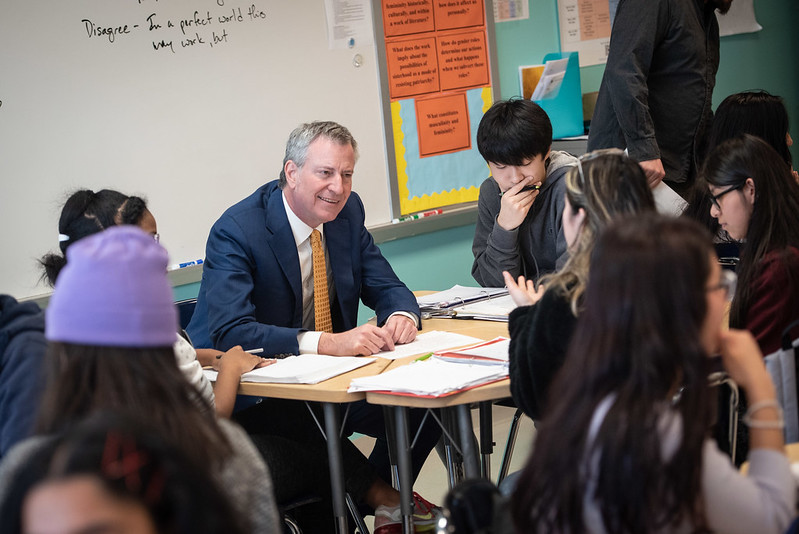
Mayor de Blasio has major school decisions to make (photo: Michael Appleton/Mayor's Office)
We’re looking at a possible school re-opening this September. I can’t wait to go back. Remote learning is better than nothing, but it’s no substitute for a live classroom. In a live classroom, I can see what students are doing. I can check their work in real time and quickly offer tips for improvement. I can urge students away from sleeping or fiddling with electronic devices.
Now I’m reduced to looking at a bunch of avatars. Who knows what the kids are doing behind them? Not me, at least. I’ve become the teacher who just sits at the desk and never ventures out to see what’s going on. In fairness, my students are in their homes and what goes on in them is none of my business. While I’ve been doing presentations lately to encourage them to come out from behind the avatars, they could have many reasons not to reveal themselves.
Of course, like my colleagues, I do the best I can. As much as I want to get back to my real job, I’m quite concerned about what a return will look like. Lots of schools are overcrowded, though not all of them quite as badly as ours.
As the most requested school in the city, Francis Lewis High School in Queens has become a victim of our own success. Mayor Bloomberg’s Department of Education overloaded us to 4,600 students, but made an agreement with the United Federation of Teachers (UFT) to reduce enrollment. We were down to almost 4,000 students when Mayor de Blasio broke the agreement and loaded us right back up again.
We’re the largest school in Queens. As far as I know, at well over 200% capacity, we’re the most overcrowded school in the city. Assuming there’s no COVID-19 vaccine by September, I’m quite concerned about what returning will look like. Even if we make two end-to-end schedules, or have half the student body come in every other day, we’ll still have a building, conservatively, at roughly 105% capacity.
Given that, how would we achieve anything resembling social distancing? Could we stagger hall passing so that only half the students are out at a time? Could we even get thousands of teenagers to respect social distancing?
It’s really hard to say. We’re at the mercy of the Mayor and New York City Department of Education, not known for thorough consideration of pressing issues. For example, we’ve long known that classes of 34 students are less than optimal for student learning. This notwithstanding, during contract negotiations one of Mayor de Blasio’s hired hands told me the city had no interest in lowering class sizes. And now the question has even more urgency: How are we going to keep students safe if we continue to pack them in like sardines?
The UFT has made health and safety of students and staff a prime consideration for school reopenings moving forward. I’m grateful to be in a union that can stand up to management. This is particularly relevant when said management saw fit to keep overcrowded schools open even as Broadway curtains were closed. I will never, ever understand why people with $800 Hamilton tickets were too fragile to go out while 1.1 million students and the many tens of thousands of staff who serve them were all crushed and pushed and shoved and mushed on subways and buses and in the halls of overcrowded buildings.
Dozens of my brother and sister unionists are now dead. Many more are, or have been, quite sick. Who can even conjecture how many of us are walking around asymptomatic and infecting others? No one can dispute that dumping us all back into a hugely overcrowded building will cause even more sickness and death.
We now know that overcrowding and huge class sizes are not only learning issues, but health issues as well. For the sake of our children, for the sake of our families, and yes for the sake of teachers and other staff, we need to stop acting like overcrowding is acceptable treatment for New York City’s children. We need a real reopening plan to help real students. Their safety is paramount.
If Mayor de Blasio wishes to salvage what reputation he has left after closing the schools too late, it behooves him to deal with this head on. If we can find space when Amazon needs it, we can find it for our students, too.
***
Arthur Goldstein is an ESL teacher and UFT chapter leader at Francis Lewis High School. He serves on the UFT Executive Board and blogs at nyceducator.com. On Twitter @TeacherArthurG.
***
Have an op-ed idea or submission for Gotham Gazette? Email This email address is being protected from spambots. You need JavaScript enabled to view it.